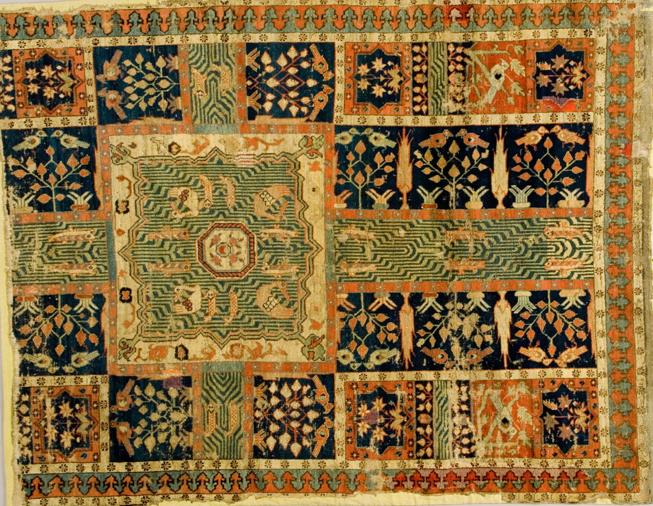
By Patrick Hunt
“And the Lord God planted a garden in the east in Eden. The Lord God made all kinds of trees grow out of the ground, trees that were pleasing to the eye and good for food. In the middle of the garden were the tree of life and the tree of the knowledge of good and evil. A river watering the garden flowed from Eden; from there it was separated into four headwaters. The name of the first is the Pishon; it winds through the entire land of Havilah, where there is gold. (The gold of that land is good; aromatic resin and onyx are also there.) The name of the second river is the Gihon; it winds through the entire land of Cush. The name of the third river is the Tigris; it runs along the east side of Ashur. And the fourth river is the Euphrates.” Gen. 2:8-14
Introduction
It has been said about Gudea, ruler of Lagash in Neo-Sumeria (ca. 2100 BCE), “He who controls the rivers controls life,” and this was certainly true in southern Mesopotamia with its necessity of irrigation for early farming. [1] The famous Louvre diorite statue of Gudea depicts him holding a vase from which two streams flow, a possible symbolic representation of both the Tigris and Euphrates rivers. Water has always been the antithesis of desert and the necessary life-giver and the source of many gardens. Indeed, gardens cannot be conceived of without water.
Some might think it a tautology in the above title to use the word paradise as an adjective for “garden” but we gardeners would not agree, especially if we might just have some kind of internal genetic template in our instinct to recreate some faintly remembered paradise in our gardens that ancient literature echoes.
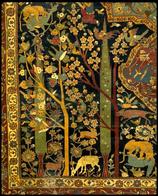
Regarding instinct, I was conducting Jean Clottes, the eminent cave prehistorian on a brief wine tasting in Northern California in late April, 2010 before his Stanford lecture. No doubt re-inspired by the streams in the nearby redwoods, I tried out an idea on him that had long been burbling through my own mind. I asked, “What if we love to hear water in our garden fountains or other places as a relaxing sound, putting our deepest minds at ease because we instinctively know the sound of running water is good for our health since our earliest human existence; this might be even earlier as an animal instinct. The opposite of this is that stagnant water meant death. What do you think?” I asked. Jean Clothes was very receptive of my idea.
A few days ago I repeated this idea and many others below in my talk “Persian Gardens on The Move: the Gifts of Persia” for the Garden Conservancy seminar on July 15, 2011. Most of these ideas are also delineated in my forthcoming book (2012) Gardens of the Ancient World. This brief article – whose shortcomings may be due partly to brevity – also condenses my Gifts of Persia talk.
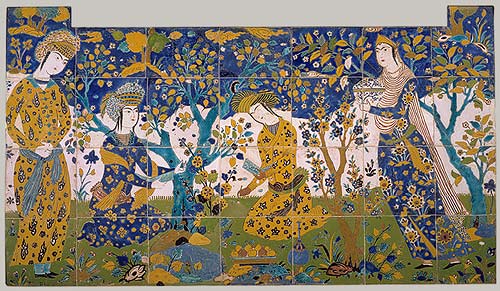
Garden of Eden as chahar bagh
In the above Genesis passage, several significant ideas leap out. First, a garden is planted; it is not an accident but a deliberate, planned entity. Second, it is not a wilderness, although it may be surrounded by wilderness of either desertified context or unkempt vegetation. Third, this first biblical garden fulfills two requisites all gardens are designed to fulfill: its trees are good for food and pleasing to the eye, that is, it has both practical and aesthetic functions. More important, this first almost mythical garden must be watered, in this case not just one but four streams are mentioned.
Last and perhaps most important, this paradise Garden of Eden as recalled in biblical literature has a vital element of Persian gardens known from the earliest examples. Biblical Eden may actually reference the Old Persian chahar bagh “four-part garden” or the Persian idea may come from even earlier Edenic memory: here Persian chahar means “four-part” and bagh means “garden”, especially important after Adam and Eve were driven out and it was guarded by cherubim (Gen. 3:23-4) as a “walled” or “protected” place, not just to preserve plants and keep water humidity high but also to keep the desert wind out (along with fallen humanity in the Eden “myth”). The allusion to the four parts of chahar bagh may be in its four rivers (Pishon, Gihon, Tigris, Euphrates) that flow therefrom, just like the Persian chahar bagh divided by four-directional water channels. The geographical context is surely at the head of the Persian Gulf below modern Iraq, and if we know two of the rivers today in the Tigris (ancient Hiddeqel [2] ) and Euphrates, it is also most likely that the Gihon (gihon means intermittent in Hebrew) is still visible in the now dry Wadi Batin that once flowed in from the west in Saudi Arabia where the Pishon is another now river (Karun) flowing in from the east and the Zagros Mountains as Zarins has surmised.[3] Naturally, the biblical Eden paradise story has many ancient Near Eastern parallels, including the legends of Dilmun, near present Bahrein. [4] Which came first or influenced the other, the idea of chahar bagh or the Eden biblical account and its far earlier literary antecedents in the Ancient Near east is a matter of debate.
Earlier Mesopotamian and later Persian gardens
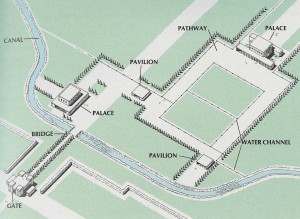
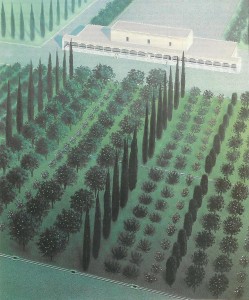
The Epic of Gilgamesh records date palm ” gardens” at Uruk as seen in Uruk Tablet 1.17-22, with a volume of at least one league.[5] Certainly gardens or orchard parks reputedly existed in 8th c. BCE Nineveh as planted by Sennacherib (more than likely the better identification for the Hanging Gardens of Babylon as Dalley notes [6]) and specified in Sennacherib’s extant texts as well as shown on Nineveh palace reliefs. Sixth century BCE Akkadian also had the word pardesu, apparently meaning “enclosed garden” ] Yet it is Achaemenid Persia where the pairi-daeza garden was given greatest emphasis.[8] The Palace of Cyrus the Great at Pasargadae was noted for its aqueduct-fed park with gardens and orchards in chahar-bagh parterre design as Stronach’s 1961-3 Pasargadae excavations have shown. [9] Quoting Stronach:
“He [Cyrus] would want to have an avenue down the length of his garden, what is often called by garden architects as ˜the vision of power”. Since we had two large rectangles, if we divided it with the ˜vision of power” we would get a four-fold garden or Chahar Bagh. In some ways, this is one of those very important Iranian discoveries in design which the world has taken as a model.” [10]
Cyrus the Great is also self-referenced as the “Good Gardener” of Persia, as were some of his successors.[11] Persepolis, Susa and other Persian palace sites continued the garden development of Cyrus. According to Herodotus in History I.108, King Astyages had a dream about his daughter Mandane, the Median mother of Cyrus the Great, in which he envisioned her pregnancy as a fruitful vine that covered Medo-Persia and Asia.
Classical Derivatives of the Persian garden
After Alexander’s conquest, the Greeks borrowed both the word and idea in the Greek paradeisos, and Xenophon especially uses paradeisos as “pleasure park”. 2] Fountains along the great Canopus Street dispensed water for many gardens in Hellenistic Alexandria in the Ptolemaic period (4th-1st centuries BCE), just one of many features of perhaps the world’s first truly cosmopolitan city.
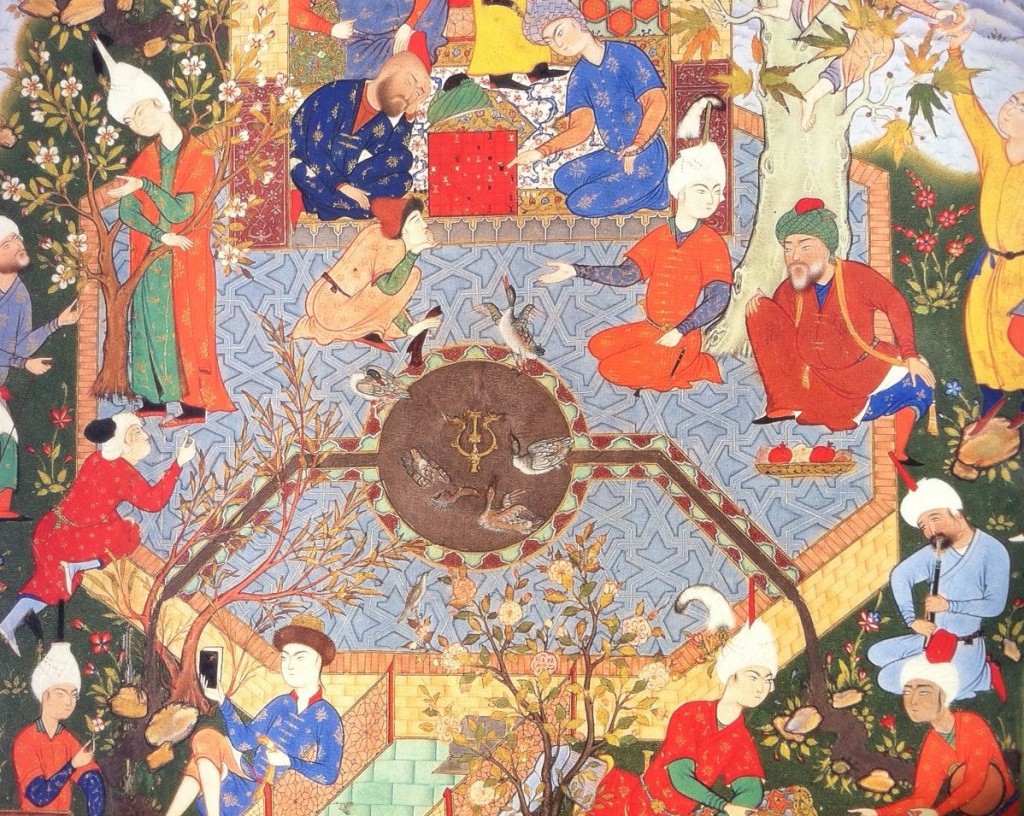
The paradeisos was later brought to Rome as paradisus, a Classical tradition derived in part from Persian antecedents. Nero’s notorious Domus Aurea enclave had park-like gardens commonly understood as paradeisoi [13] and the peristyle hortus gardens seen in upper class Roman villas and Pompeiian houses, e.g., House of the Vettii, are in some sense a form of urban private paradisus. Curtius Rufus also describes paradeisoi as “hunting parks”. 4] Jashemski concurs that exotic animal parks are essentially the Roman version of this idea in wall paintings. [15] Rome itself had many gardens (horti), including the famous Hortus Sallustius and the Garden of Maecenas, along with that of Agrippa, as well as the Horti Lamiani, Licinii, Luculliani, Pallantiani. [16] The Pincian Hill and semi-rural areas of both Vaticanum and Janiculum Hills also had extensive gardens and parks in rich houses and villas. Many of these private Roman villa gardens were ultimately appropriated and incorporated into imperial estates. [17] Gardens in villas are Roman versions of the paradisus as a pleasure garden because of their size and range of plants and trees as well as watercourses, especially watered by the many aqueducts feeding Rome. [18]
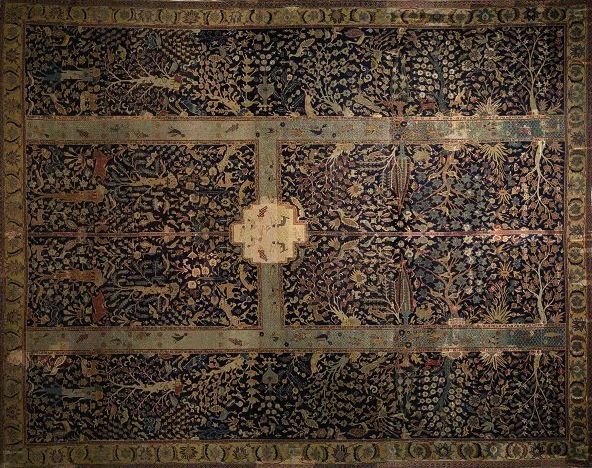
Biblical pardes
On the other hand, there are biblical references seemingly earlier than the Classical World. Song of Songs 4:13 attributed to Solomon [19] has used the Old Persian word and idea in the late Hebrew word pardes [20] in part for the legendary royal pleasure gardens of Jerusalem, possibly also influenced by earlier Phoenician mercantile contact with Mesopotamia, although ancient Egypt – especially the better-documented New Kingdom – also had both sacred and secular gardens,[21] as the painted fresco garden from the Tomb of Nebamun (ca. 1350 BCE) in the British Museum shows, among others.[22] The putatively Solomonic Qohelet (Ecclesiastes) 2:5 states, “I made myself gardens and orchards, and I planted trees in them of all kinds of fruits.” Literature putatively or traditionally associated with Solomon use either the borrowed word pardes or the word gan for garden contexts in Hebrew.
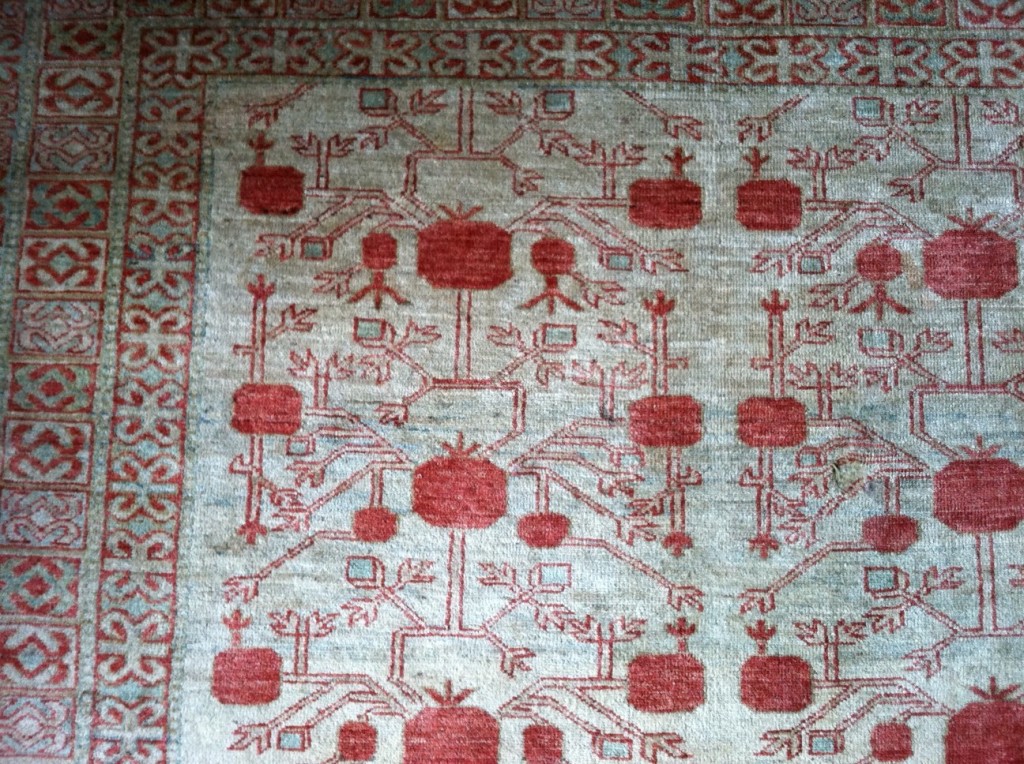
Following the legendary Solomon, Esther 1:5 is another biblical reference to a pardes at Shushan (Susa) : “garden of the king’s palaces” where the Persian king Ahasuerus (Xerxes) himself may have planted trees [23] – as in Nehemiah 2:8 (“king’s forests”) -although these post-Solomon references are clearly in the period of Persian domination and cultural influence over Judah between the Babylonian Captivity and the early Seleucids, roughly ca. 604-300 BCE.
In a separate development from Classical or biblical borrowings, the tradition of Persian influence in the Mediterranean world was repeated much later in the 7th to 9th centuries CE when the advance of Islam and spread of Arab culture again brought the Persian garden as a new wave to the Mediterranean world through North Africa, Sicily and Spain. Moorish landscape planning incorporated the Persian garden into what would eventually become a European garden design in the medieval epoch as assimilated from contexts in Sicily and elsewhere; from the 10-11th c. in Sicily and the 14th c. in Spain.
Persian Rugs as Paradise Gardens
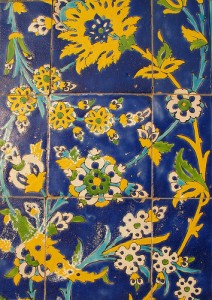
Arthur Upham Pope said, “The garden in all its splendid aspects is the basic theme of Persian carpets.” The first famed paradise carpet of note to be recorded was that of the Sassanid ruler Khosrow I (531-571 CE). This lost paradise carpet was described by the iconic Arab historian Muhammad ibn Jarir al-Tabari (c. 839-923 CE), an important source for the history of early Islam. In al-Tabari’s words: at the Ctesiphon palace of Kisra I (Khosrow I):
“[There] was a huge carpet, depicting a garden with streams and paths, trees and beautiful spring flowers. The wide border all round showed flower beds of various coloring, the flowers being blue, red, yellow, or white stones. The ground was yellowish, to look like earth, and it was worked in gold. The edges of the streams were worked in stripes, and between them stones bright as crystal gave the illusion of water, the size of the pebbles being what pearls might be. The stalks and branches were gold or silver, the leaves of trees and flowers made of silk, like the rest of the plants, and the fruits were colored stones.” [25]
In beautifully illustrated traditions of Persian design lasting for millennia, these rugs often echo paradise gardens with a primary source of textile inspiration in the chahar bagh, as notable “paradise garden” rugs like the first image in this article demonstrates – often with a “pool” enclosed by “walls” – from before and during the Safavid Dynasty in Persia. Shah Tahmasp (1514-76) gave great stimulus to the Persian textile industries as proud national crafts. As Franses has noted:
“Gardens and the quest for paradise have been fundamental to Iranian thought ever since [Cyrus], and are continuously expressed in poetry, literature and painting. The carpet is a mirror of heaven and a transportable ground plan; what better medium of artistic expression could have been created for the garden, as the essence of Iranian life has always been the move between summer and winter quarters? To be able simply to roll up and carry one’s personal garden must have had tremendous appeal to poor and rich alike.” [26]
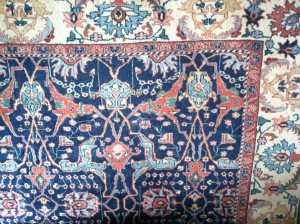
Some of the more famous “paradise garden”carpets of substantial size; these include about 15 rug treasures from Shah Tahmasp to Shah Abbas I and their successors – e.g., the Schwarzenberg “Paradise Park” Rug, ca. 1550, formerly in Vienna, now in Qatar; the “Ardabil” Rug (although non-figural and possibly from Mashad) [27] , ca. 1539-40, in London’s Victoria and Albert Museum and its somewhat twin at Los Angeles County Museum of Art (LACMA); the˜Wagner Carpet”, ca. 1650 onward, in the Burrell Collection of Glasgow, [28] as well as the Safavid period Mantes Carpet at the Louvre.[29] Some of these carpets, like the ˜Wagner” have clear chahar bagh designs, emphatically showing the Persian garden as inspiration. Brend comments that “Garden carpets probably developed from the town-planning activities of Shah ‘Abbas, since they are in effect picture maps.” [30]
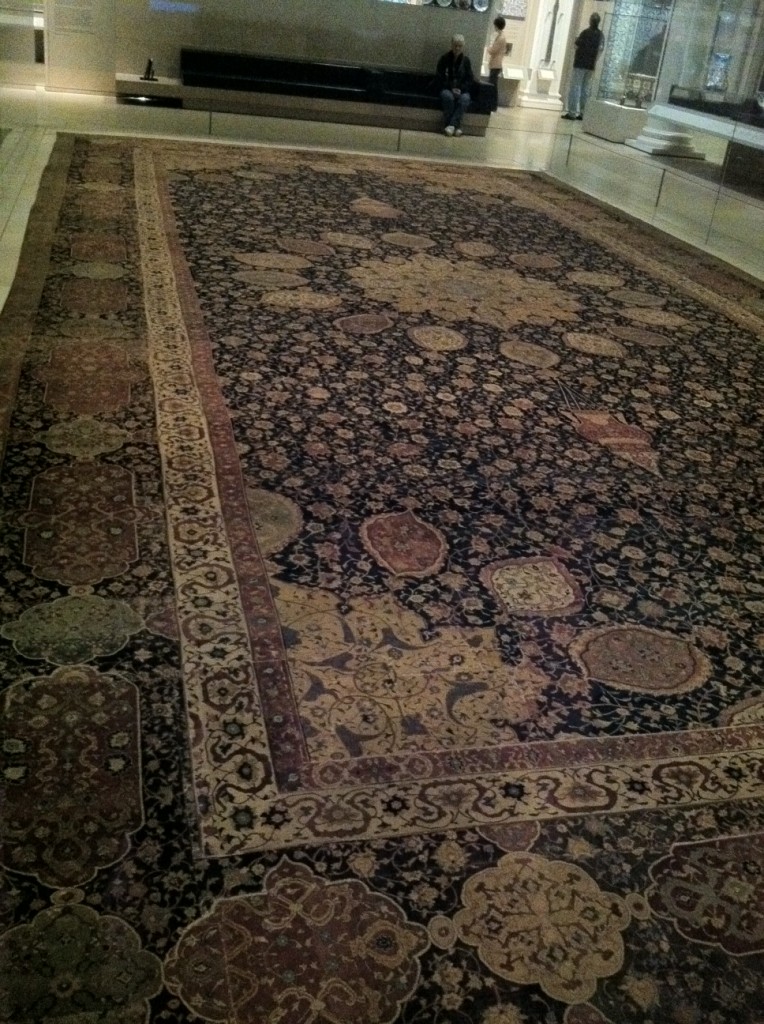
Persian and Persian-influenced “Garden Tiles”
The former Bey’s Palace roof terraces in the Medina of Tunis still has beautiful tile portions with tile mural garden scenes, as I recently saw in 2008. The Louvre Museum has another lovely garden scene in mural tiles, [31] as does the Victoria and Albert Museum in London, [32] which I revisited in the spring of both 2010 and 2011, among many other occasions. Another Islamic garden context with a chahar-bagh plan is from the 19th c. in Marrakech, Morocco: the Bahia Palace of Si Musa, the Grand Vizier to Sultan Muhammed bin And-al-Rahman Si Musa (continued by his son). Here in a lush garden courtyard between the mosque and mudrasa of the palace is a chahar-bagh of four zellij-tiled alleys meeting at a fountain. These are just a few of many such gardens of Near Eastern design.
Most of these rugs mentioned have people in the gardens as well as trees and plants, whereas Islamic decorated tiles primarily have intertwined plant and flower lacework without people, especially at Isfahan’s Great Royal Shah Mosque (Masjid-i-Jami Abbasi) constructed from 1612-30, where thousands of tiles form intricate garden foliage both inside the ivans and outside on its dome, as in other mosque tile contexts. [33] Ottoman Iznik ware and tiles as seen at the Victoria and Albert Museum in London, at the Royal Academy 2005 Exhibition in London and at Topkapi Palace in Istanbul and elsewhere repeat the wonders of the original Persian garden tiles. [34]
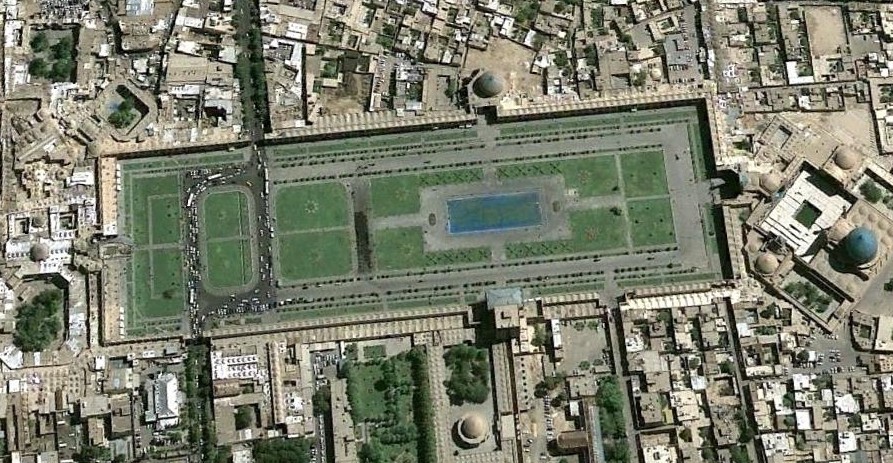
Solomonic to Medieval gardens and Mediterranean Islamic gardens
The recreated mythical biblical garden of the hortus conclusus is often thought to be from Solomon in the passage from Song of Songs 4:12, “a garden enclosed [gan na’ul] is my sister, my spouse”). This idea also drew upon the prior Classical borrowing of this Persian theme in later medieval cloister gardens, as at Romanesque Monreale above Palermo in Sicily or St. Trophime at Arles – where clerics, especially women, became the virtual Bride of Christ and were essentially sequestered outside of the public eye. In one of the clearest examples of Sassanid Persian textile influence, the golden field mosaics from the Salle de Roger II in the Palazzo Normanni in Palermo demonstrates the balanced designs of Sassanid artistic dual symmetry just as seen on Sassanid silks and their Byzantine copies, including the treasure of the silk Shroud of St. Sernin at Toulouse with its obvious Kufic scripts.
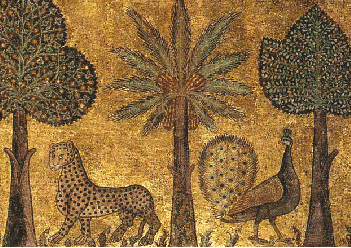
In Granada of the Moorish Al-Andaluz, the Alhambra of the Nasrid Dynasty and the Generalife Garden (Jannat al-Arif, the “Architect’s Garden”) also continued the Persian model with four-part harmony of gardens, fountains and reflecting pools. [35] In Sicily, in an enlightened period of cooperative tolerance not seen since, the Rogerian dynasty of Palermo peacefully employed Christian, Islamic and Jewish court officials, engineers and artists. The Palazzo Normanni was a medieval wonder, and Palermo was praised by the great Arab geographer Muhammad al-Idrisi (ca. 1099-1166) who had travelled from Ceuta in Spain to York (Britain), from Turkey to France as well as across North Africa, stating: “Balarm [Palermo] the Beautiful is an immense city, the greatest and most splendid of its day, the most influential and excellent metropolis in the world.” Al-Idrisi also completed the most complete map of the time with his famous world atlas Tabula Rogeriana for the court of Roger II in 1154. Al-Idrisi certainly understood what he was comparing.
The extant Norman period art and architecture of the Palazzo Normanni is splendid, especially the Salle de Roger (actually dating to William I-II, c. 1160-70) with its hybrid Sassanid and Islamic influences where the architectural layout is mostly Arabic with Persian sources. In this Palermo context are mosaic walls with likely Byzantine-trained artisans of gardens and a pairi-daeza of fruit and date palm trees with leopards peacocks, griffins, stags (all typical Persian beasts) as well as other animals all on a gold background. Equally, the Hall of the Four Columns (or Four Winds) also has clear Sassanid silk textile motifs of symmetrically-facing animals surrounded by roundels. [36]
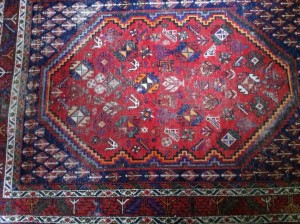
Just a few hundred meters from the Palazzo Normanni crowning Palermo above the old Islamic Kalsa district, the red-domed church of San Giovanni degli Eremiti and its adjacent Islamic garden and wells reincorporated as a cloister garden emphatically show this cooperative hybrid architecture. Small wonder then that Boccaccio praised Sicilian Palermo as the pearl of the 13-14th century, the wealthiest city in Europe at the time. Other contemporaries of the time remember the royal groves of lemon trees around the Palazzo Normanni whose thousands of blossoms perfumed the air of the upper city and valley above toward Monreale. This was the medieval Rogerian version of the pairi-daeza of Cyrus. Palermo’s culminating 13th century glory maintained by Frederic II, stupor mundi (“wonder of the world”) however, was too philosophically eclectic and tolerant for the Church. Frederick was twice excommunicated [37] but able to win back Jerusalem without a drop of Saracen blood spilled in his diplomatic but unblessed Sixth Crusade [38], breaking the rules of the crusading Church which demanded death of Saracens. The civilized Frederick was also a lover of gardens.[39]
Safavid and Mughal Paradise Gardens and their European heirs
In the 16th to 17th centuries, Safavid Persia and the Mughal Empire continued the indigenous chahar-bagh four-part tradition of the Near Eastern gardens of antiquity with pools, trees and perfumed flowering plants. [40] Ordering the chahar-bagh along formulaic standards, the Persian author Qasim b. Yusuf Abu Nasiri wrote a 16th c. garden treatise Irshad al-zira “Of the ideal garden”, chahar-bagh in design, and even recommended specific trees and vegetation as well as dimensions. [41]
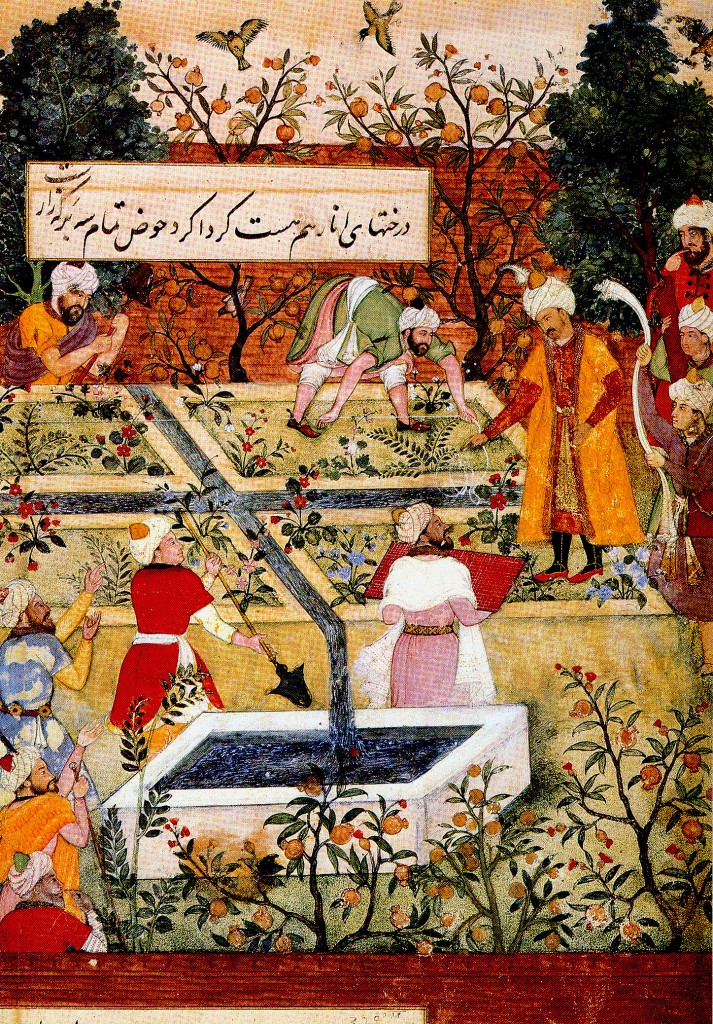
Just a few examples of Persian chahar- bagh gardens between 1500-1730 include the Safavid period Meidan Square of the Great Mosque in Isfahan with its immense size, well more than 85,000 square meters of garden enclosure in the Great Square as a legacy of Shah Abbas (1571-1629). [42] Elsewhere, the gardens of the Mughal Taj Mahal had similar plans [43] and at Shiraz the Musalla Gardens of the Tomb of Hafez (1315-90). Also the Bagh-e Jahan Nama and the Bagh-e Eram Paradise Garden, both at Shiraz, and the Bagh-e Fin at Kashan, [44] to name just a few, continue the Persian chahar-bagh design. Even the Mughal c. 1590 Baburnama in the British Library shows miniature paintings with the Emperor Babur in a charbagh (Mughal spelling) garden accompanied by his courtiers, as do other miniatures showing his Garden of Fidelity or directing his gardeners from images a century later. [45]
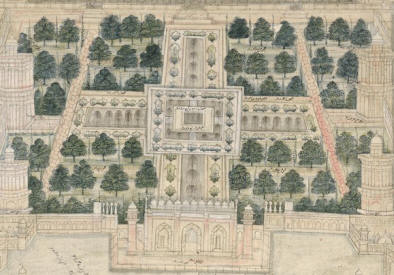
Subsequent Renaissance gardens, for example, may not consciously echo Persian chahar- bagh paradise gardens but are nonetheless partly derivative. Four-part plans are seen in the many contemporary paintings of fifteenth century Medici gardens in and around Florence (e.g., Trebbio, Cafaggiolo, Careggi, Fiesole) and the later Castello and Boboli villa gardens. [46] In addition, the remnant garden of the Villa Farnesina in Rome adjacent to the Tiber – which location may be over the Garden of Agrippa in imperial Rome – along with the later Borghese Gardens above the Pincian Hill in Rome, are all orderly four part parterre gardens of Renaissance and Baroque splendors, and nonetheless indirect descendants of the Persian garden envisioned by Cyrus the Great, where the royal pairi-daeza enclosed bits of paradise on earth, an ordering of nature within chahar-bagh design just as in the Garden of Eden watered by pools and fountains with planted pleasures of trees and flowers for refreshing both body and soul.
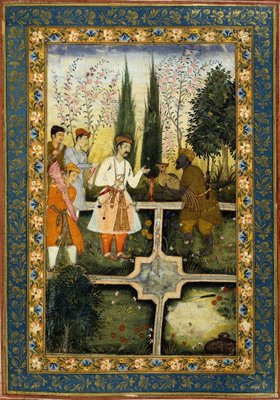
Conclusion
Persian gardens and their Islamic successors continued to inspire subsequent gardens with their design and purpose even if many later gardens may not have any religious or civic function. But as Brend simply and magisterially puts it:
“It is not surprising that the design of Islamic gardens and garden courts is governed by the square grid of water channels which derives from the practical needs of irrigation. Nor is it strange that every vision of Paradise which Islam offers to the believer is that of a garden with running waters, and that every garden in the Islamic world tends to be seen as a metaphor for Paradise.” [47]
While a first paradise was lost and remembered or dreamed only in literature or gardens, carpets, tiles and other ways in the Near East, a second future paradise may be partially previewed in a biblical prophetic book. In Ezekiel 47:12 the exilic prophet envisions a better future in his challenged present of Babylonian captivity. He rhapsodizes about the new trees planted by God and watered by a river flowing directly from the new temple in the New Jerusalem: “all the trees have fruit for food and leaves for the healing of the nations.” Like the first pleasure garden in Eden, “pleasing to the eyes” well as good for food, this ultimate garden also fills multiple roles as a garden should. This desire of all desires, the ultimate pairi-daeza will be for feeding and healing both body and soul, just as the Persians have always known their gardens to be able to do.
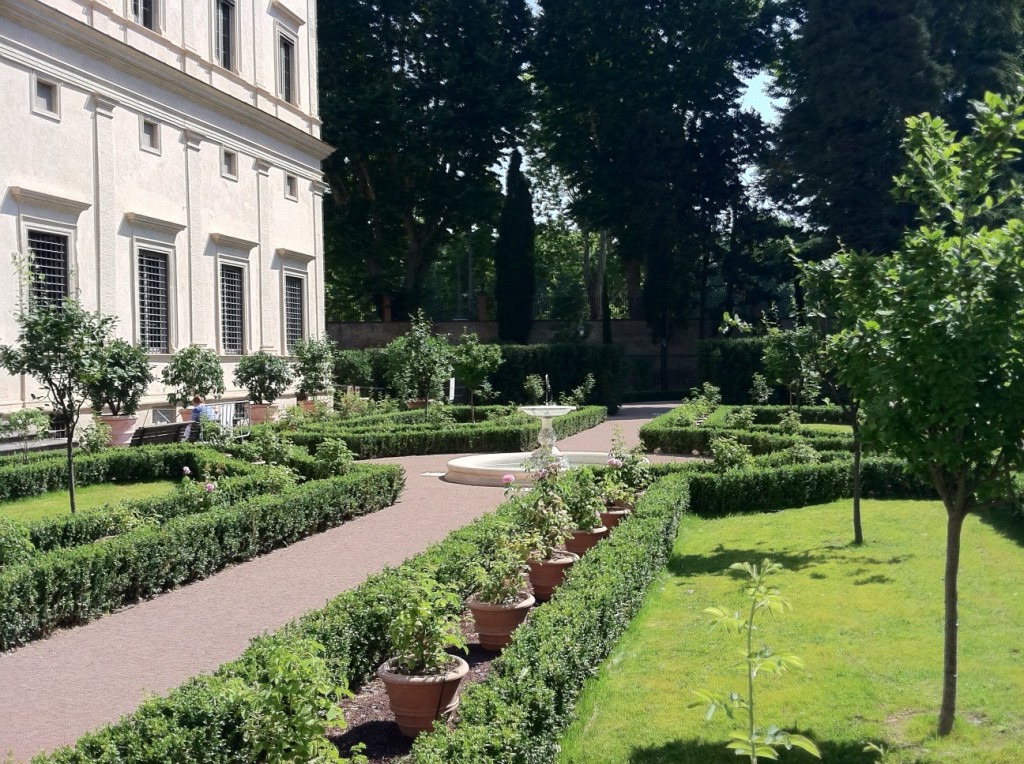
Relative Chronology of Near Eastern and Persian Garden “Multiple Waves” of Influences
3rd millennium BCE Epic of Gilgamesh describes civic date palm gardens at Uruk
8th c. BCE Sennacherib, Assyrian king, creates irrigated Nineveh gardens (“Hanging Gardens?) adjacent to Kyunjik palace
7th c. BCE Descriptions of Eden in Genesis imply fourfold rivers watering a Pre-Persian Paradise garden influenced by or influencing Zend-Avestan legends
6th c. BCE Late Akkadian word pardesu and Avestan and Persian word pairi-daeza for garden or orchard, possibly walled
6th c. BCE Cyrus the Great plants his chahar-bagh (four-part) garden and orchard at Pasargadae, his successors continue
6th c. BCE Song of Solomon edited (Song of Songs 4:13) Hebrew poetry describes the lover as an “enclosed garden”
4th c. BCE Alexander the Great’s legacy introduces the Greek version of paradeisos from Persia to Alexandria and Greece
1st c. BCE-1st c. CE Romans create hortus conclusus gardens at Pompeii (e.g. House of the Vettii)
1st c. BCE – 1st c. CE Roman horti replicate elements of Greek paradeisos in Rome, especially Nero’s Golden House landscapes
6th c CE Sassanid (Persian) King Choesroe commissions first major paradise garden rug at Ctesiphon
7th -8th c. CE Islamic expansion brings the Persian Garden to North Africa, Spain and Sicily
11-12th c. CE Rogerian Dynasty in Sicily replicates gardens and orchards in mosaic in Palazzo Normanni
11-12th c CE Romanesque Cloisters landscape four-part hortus conclusus
13-15th c CE Al-Andaluz Moors in Spain create Persian-inspired gardens at Granada (Alhambra and Generalife), Nasrid Dynasty
14-17th c CE Persian rulers especially Safavids create chahar-bagh urban gardens and tiles in Isfahan, Shiraz, etc.
14-7th c. CE Persian rulers encourage Paradise Garden rug industry
15-16th c. CE Italian Renaissance creates four-part garden landscapes in Rome, Florence, etc. (e.g. Villa Farnesina)
16th c. CE Iznik ware in Turkey replicates Persian garden motifs in tiles and tableware, etc.
17th c CE Baroque and later gardens replicate four-fold garden design (e.g. Versailles)
References:
Barbara Brend. Islamic Art. Harvard University Press, 1996, 2nd pr.
M. Carroll. Earthly Paradises: Ancient Gardens in History and Archaeology. Los Angeles: Getty Publications, 2003
Amanda Claridge. Rome: Oxford Archaeological Guide. Oxford: Oxford University Press, 1998
Filippo Coarelli. Rome and Environs. Berkeley: University of California Press, 2007
Eric Cline. From Eden to Exile: Unraveling Mysteries of the Bible. Washington, DC: National Geographic, 2007
Penelope Hobhouse. Gardens of Persia. London: Cassell/Kales, 2004
Patrick Hunt. Gardens of the Ancient World, 2012 (in press)
Mehdi Khansari, M. Reza Moghtader and Minouch Yavari. The Persian Garden: Echoes of Paradise, 2003
Farzin Rezaeian. Incredible Isfahan: Discovering Persia’s Past. Sunrise, 2010
David Stronach. Pasargadae. Oxford: Oxford University Press, 1978
James Wescoat and Joaichim Wolschke-Bulmahn, ds. Mughal Gardens: Sources, Places, Representations and Prospects. Dumbarton Oaks, Arthur Sackler Gallery, Smithsonian, 1996
Acknowledgment is humbly given to David Stronach, peerless scholar, mentor and friend, beginning from when I was his Post-Doctoral Research Fellow 1992-94 in Near Eastern Studies at University of California, Berkeley; also to Betsy Flack of the Garden Conservancy, sponsor of the “Gifts of Persia” Seminar Lectures, July, 2011.
Notes:
[1] Dietz Otto Edzard. Gudea and His Dynasty. Toronto: University of Toronto Press, 1997; Patrick Hunt. “Gudea, King of Lagash”, Great Lives from History: The Ancient World, 2004, vol. 1, 366-69
[2] In phonology, minimal pairs include possible substitutions of t for d, and g for q/k whether voiced (engaging vocal folds/cords) or unvoiced, as well as the similarity between l and r, thus hiddeqel : ignoring vowels [h]dql minus [h] can become tigris : tgr plus[s].
[3] J. Zarins. “The Early Settlement of Southern Mesopotamia: A Review of Recent Historical, Geological and Archaeological Research”, Journal of American Oriental Society 112.2 (1992) 55-77; J. Zarins. “Euphrates” in Eric M. Meyers, ed. The Oxford Encyclopedia of Archaeology in the Ancient Near East, vol. 2, New York: Oxford University Press, 1997, 287-290; also see Jeffrey Rose. “New Light on Human Prehistory in the Arabo-Persian Gulf Oasis.” Current Anthropology 51. 6 (2010) 849-883.
[4] M. Rice. Search for the Paradise Land: An Introducton to the Archaeology of Bahrain and the Arabian Gulf from the Earliest Times to the Death of Alexander the Great. London: Longmans, 1985, 120-24; H. J. Nissen. “The Occurrence of Dilmun in the Oldest Texts of Mesopotamia” H. Khalifa and M. Rice, edd. Bahrain Through the Ages. London: Kegan and Paul, 1986, 335-39; H. I. MacAdam. “Dilmun Revisited.” Arabian Archaeology and Epigraphy, vol. 1 (1990), 49-87, esp. 55; J. Delumeau. History of Paradise: The Garden of Eden in Myth and Tradition. Urbana: University of Illinois, 2000, 6; Eric Cline. From Eden to Exile: Unraveling Mysteries of the Bible. Washington, DC: National Geographic, 2007, 2-15
[5] Susan Pollock. Ancient Mesopotamia: The Eden That Never Was. Cambridge: Cambridge University Press, 1999, 48
[6] Stephanie Dalley. “Nineveh, Babylon and the Hanging Gardens: Cuneiform and Classical Sources Reconciled.” Iraq 56 (1994) 45-58; also see Karen P. Foster. “The Hanging Gardens of Nineveh.” Iraq 66 (2004) 207-20.
[7] Scott Noegel and Gary Rendsburg. Solomon’s Vineyard: Literary and Linguistic Studies in the Song of Songs. Atlanta: Society of Biblical Literature, 2009, 175.
[8] Bruce Lincoln. “La recherche du paradis perdu.” History of Religions 43.2 (2003) 139-54, esp. 47 & ff.
[9] David Stronach, “Pasargadae” in Ilya Gershevitch, ed. The Cambridge History of Iran, vol. 2, The Median and Achaemenian Periods. Cambridge: Cambridge University Press, 1985, 838-855; David Stronach. “The Royal Garden of Pasargadae: Evolution and Legacy.” Archeologia Iranica et Orientalis. Miscellana in Honorem Louis Vanden Berghe, Ghent, 1989, 475-502; David Stronach. “Parterres and Stone Watercourses at Pasargadae: Notes on the Achaemenid Contribution to the Evolution of Garden Design.” Journal of Garden History 14 (I994): 3-12.
[10] Farzin Rezaeian. Incredible Isfahan: Discovering Persia’s Past. Sunrise, 2010, 131.
[11] Pierre Briant. A History of the Persian Empire, Eisenbrauns, 2006, 232-234 & ff.
[12] Xenophon, Anabasis I.2.7, referring to a paradeisos of Cyrus the Younger in Celaenae, Phrygia; also see Theophrastus Historia Plantarum 4.4.1
[13] Suetonius, Life of Nero 31.1: item stagnum maris instar, circumsaeptum aedificiis ad urbium speciem; rura insuper arvis atque vinetis et pascuis silvisque varia; Tacitus, Annals XV.42: domum, in qua haud proinde gemmae et aurum miraculo essent, solita pridem et luxu vulgata, quam arva et stagna et in modum solitudinem hinc silvae, inde aperta spatia et prospetus ; Elisabetta Segala, ed. Domus Aurea, Rome: Electa / Soprintendenza Archeologica di Roma, 1999 (2003 repr.) 12-13, 24-25; Annette L. Giesecke, “Beyond the Garden of Epicurus: The Utopics of the Ideal Roman Villa.” Utopian Studies 12.2 (2001) 6 [paradeisos]; also see Patrick Hunt. “Nero” in Notorious Lives: Great Lives in History, Salem Press, 2007.
[14] Curtius Rufus, Historiae Alexandri Magni 8.1.1
[15] Wilhelmina Feemster Jashemski and F. G. Meyer, eds. The Natural History of Pompeii. Cambridge: Cambridge University Press, 2002, 404.
[16] Amanda Claridge. Rome: Oxford Archaeological Guide. Oxford: Oxford University Press, 1998, 14, 23, 132-33, 174, 179-80, 267-68, 270, 384.
[17] Filippo Coarelli. Rome and Environs. Berkeley: University of California Press, 2007, 19, 198-200, 234, 241-44, 257-58, 326, 337, 447.
[18] Elisabeth Blair MacDougall, ed. Ancient Roman Villa Gardens. Colloquium on the History of Landscape Architecture 10. Washington DC: Dumbarton Oaks Research Library, 1987.
[19] In the 10th century according to Noegel and Rendsburg, 54, more on pardes, 175-78 & ff.
[20] Patrick Hunt. Poetry in the Song of Songs: A Literary Analysis. New York, Frankfurt: Peter Lang, 2008, 6.
[21] M. F. Moens. “The Ancient Egyptian Garden in the New Kingdom: A Study in Representations”, Orientalia Lovaniensia Periodica 15 (1984) 11-53 (Moens lists 20 wall paintings and 1 relief for the New Kingdom); M. Carroll. Earthly Paradises: Ancient Gardens in History and Archaeology. Los Angeles: Getty Publications, 2003, 24-5.
[22] British Museum, Room 61, Cohen Gallery, from Thebes, late 18th Dynasty, # EA 37983, 64 cm high; also see Richard Parkinson. The Painted Tomb-Chapel of Nebamun. London: British Museum Press, 2008
[23] as seen in Briant’s Vulgate gloss of Esther 1:5, 234
[24] Arthur Upham Pope and Phyllis Ackerman. A Survey of Persian Art, vol. 3. New York: Oxford University Press, 1938-39, ch. 44; quoted in Mehdi Khansari et al. The Persian Garden: Echoes of Paradise, 2003, 153
[25] Michael Franses. “Safavid Carpets in the Museum of Islamic Art, Qatar.”Hali 155 (2008) esp. 7-8.
[26] ibid, 3-25
[27] Daniel Walker. “Carpets – Safavid Persia IX. Encyclopaedia Iranica.
[28] Barbara Brend. Islamic Art. Cambridge, MA: Harvard University Press, 1996, 2nd pr., 170-73.
[29] Paris, Louvre Museum, Mantes Carpet, late 14th c. Islamic Art # OA-6610, 3.79 x 7.83 m; also see Encyclopaedia Iranica, vol X, fascicle 2, New York, Bibliotheca Persica Press, 2000, 156-159
[30] Brend, 170, text for plate 117 on “Wagner” Carpet
[31] Paris, Louvre Museum, Mural Tiles, first half of 17th c., Islamic Art # OA-3340, mostly blue, yellow and green on white, 1.15 (h) x 1.72 (l) meters.
[32] Ardabil Carpet, Victoria and Albert Museum, London, Gallery 42, Safavid, from Isfahan, 17th c., blue, yellow and green on white, 1.04 (l) x 2.21 (h) meters.
[33] Rezaeian. 111, 114-20
[34] David Roxburgh, ed. Turks: A Journey of a Thousand Years: 600-1600. London: Royal Academy of Art, 2005 ,Iznik, 104-05, 263-64, 312-13, 330-31, 446-47, 453-55, 460-62.
[35] Michael Jacobs. Alhambra. New York: Rizzoli, 2000, 15, 28, 32, 44, 112; Brend, 55.
[36] Gioacchino Lanza Tomasi and Angheli Zalapi. Palaces of Sicily. “Palace of the Normans” New York: Rizzoli, 1998, 228-33
[37] Sebastien Mamerot. A Chronicle of the Crusades, vol. II. Thierry Delcourt, Danielle Quaruel and Fabrice Masans, eds. Cologne: Taschen, 2009, 165, regarding one the of excommunications of Frederick at the Council of Lyon by Pope Innocent IV in 1245.
[38] T. C. van Cleve. “The Crusade of Frederick II in K. Setton, ed. A History of the Crusades, vol. 2. The Later Crusades. Phildelphia, 1962; David Abulafia. Frederick II: A Medieval Emperor. New York: Oxford University Press, 1992, 164-201
[39] Abulafia, 8, 29
[40] Penelope Hobhouse. Gardens of Persia. London: Cassell / Kale, 2004, 8, 84, 95, 112-114, 116, 118, 121, 124, 137, etc.
[41] D. Fairchild Ruggles. Islamic Gardens and Landscapes, Philadelphia: University of Pennsylvania Press, 2007, 61; Khansari et al., 65
[42] Rezaeian, 78- & ff.
[43] James Wescoat and Joaichim Wolschke-Bulmahn, ds. Mughal Gardens: Sources, Places, Representations and Prospects. Dumbarton Oaks, Arthur Sackler Gallery, Smithsonian, 1996, 13, 24, 86, 117, 172, 177, 216, 225, 259, etc.
[44] Khansari et al., 63, 76-78, 124, 129
[45] Wheeler Thackston, tr, ed. The Baburnama: Memoirs of Babur, Prince and Emperor. New York: Modern Library, 2002; Khansari et al., 65.
[46] Raffaella Fabbiani Giannetto. The Medici Gardens of Fifteenth-Century Florence: Conceptualization and Tradition. University of Pennsylvania Ph.D. Dissertation, University of Pennsylvania Libraries, 2004.
[47] Brend, 12